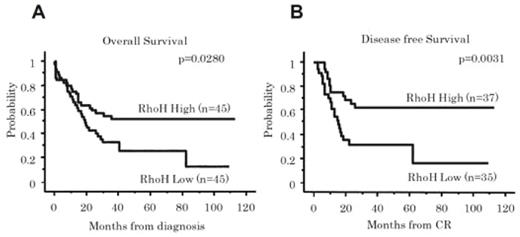Abstract
The Rho family of small GTPase, including Rho, Rac and Cdc42, has been well characterized as a molecular switch that transduces signals from plasma membrane to the downstream effectors. RhoH gene, a member of the Rho family, is specifically expressed in hematopoietic cells. As RhoH is GTPase-deficient and constitutively active, the activity of RhoH is directly related to its level of expression. Previous reports demonstrated that the aberrant somatic hypermutation of RhoH is a novel mechanism of lymphomagenesis, possibly through its deregulated expression, suggesting that RhoH is the proto-oncogene. The known function of RhoH is antagonizing Rac and mediating activation of ZAP-70 in T lymphocytes. Recent report demonstrated that hairy cell leukemia is characterized by low expression of RhoH, and reconstitution of this gene limits malignant progression and protects against mortality. Although the functions of RhoH in lymphoid cells have been clarified, the biological roles of RhoH in the myeloid cells are unknown. The question that whether RhoH expression affects the prognosis of acute myeloid leukemia patients still remains unanswered. Here, we analyzed the expression level of the RhoH gene transcript in bone marrow samples from 90 newly diagnosed acute myeloid leukemia patients using a real-time fluorescence detection method. The RhoH/GAPDH ratio was calculated, and the median of 90 samples was 1.57. The patients were then divided into RhoH high (i.e. RhoH/GAPDH above 1.58) and RhoH low groups. The expression level of RhoH was not related to the FAB classification, age, WBC counts, cytogenetics or complete remission rate. In addition, RhoH expression was not associated with the known gene mutations such as NRAS, FLT3 and TP53. Kaplan–Meier analysis demonstrated that low expression of the RhoH transcript was a predictor of worse prognosis in both overall (Fig.1A) and disease-free survival (Fig. 1B). Patients were then categorized into favorable, intermediate, unfavorable and unknown cytogenetic groups based on the Southwest Oncology Group and Medical Research Council cytogenetic risk category definition. Kaplan–Meier analysis for both overall and disease-free survival was performed for 65 (72.2%) patients in the intermediate risk group. The results indicated that low expression of the RhoH transcript is a worse prognostic factor for both overall and disease-free survival in the intermediate risk group (p = 0.03 and 0.001, respectively). Multivariate analyses showed that presence of theTP53 mutation (relative risk (RR), 10.175; p = 0.0036), high WBC count (RR, 3.457; p = 0.0003) and low RhoH expression (RR, 2.272; p = 0.0091) were independent poor prognostic factors for overall survival. The same analysis revealed that the presence of the TP53 mutation (RR, 14.292; p = 0.0168), low RhoH expression (RR, 4.854; p = 0.0002), high WBC count (RR, 2.901; p = 0.0187) and presence of FLT3/ITD (RR, 2.515; p = 0.0419) were independent poor prognostic factors for disease-free survival. Next, we investigated the biological roles of RhoH in AML. Overexpression of RhoH leads to dephosphorylation of Bad at Serine (S)-75 (corresponding to murine S112) possibly through deactivation of Rac. Contrastingly, RhoH expression does not affect phosphorylation of S99 (corresponding to murine S136) of Bad and S473 of Akt. It is possible that low expression of RhoH (i.e. high GTP-Rac) contributes to chemotherapy resistance in leukemia cells. Taken together, our results highly suggest that RhoH transcript level is an effective molecular marker to further stratify the patients in the intermediate risk group of AML, and that inhibition of Rac and its signalling components might provide a useful anti-leukemic strategy.
Disclosures: Kiyoi:Kyowa Hakko Kogyo, Co. Ltd.: Consultancy.
Author notes
Corresponding author


